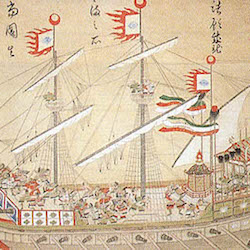Battle of Sekigahara, Tokugawa family seizes control over Japan.

Establishment of the Dutch East India Company.
Dutch East India Company arrives in Japan, sets up outpost in Hirado.
VOC concludes treaty with head of Japanese community in Siam to deliver deerskins.
View of Fort Zeelandia

While the Company was created to seize control of the rich spice trade of Southeast Asia, it also moved aggressively into East Asia. There, it quickly became clear that the organization’s fortunes depended on gaining access to Chinese commodities. The problem was that Chinese administrators had repeatedly rejected VOC requests for trade. Dutch officials believed they had at last found the solution in 1622 when their forces began to fortify the Penghu or Pescadores islands, which lay in the Taiwan straits between China and Japan seemingly outside the influence of the Chinese state. Rather than going unnoticed, however, the establishment of a small fortress on the Penghus provoked a fierce response from local commanders who massed a fleet to expel the invaders and restore order. Eventually a compromise was reached when the Dutch agreed to retreat to nearby Taiwan, which lay, they were assured, “outside the jurisdiction of China.” In 1624, the Company commenced construction of a stronghold, later christened Fort Zeelandia, on a sandbank in the bay of Tayouan, a key maritime hub that lay on the west coast of the island. From a thin sliver of land, VOC control quickly spilled over to Taiwan proper where the Company came into contact with several thousand Siraya villagers, the members of sub-group within the larger Taiwanese aboriginal population that occupied the coastal plans spread across the southwest of the island.
Dutch East India Company occupies part of Taiwan. Establishes Fort Zeelandia.
'Embassy' from Taiwan arrives in Edo to establish ties with the Bakufu.
Trade between VOC and Japan breaks down due to conflict with Suetsugu Heizo.

Pitfall hunting technique introduced in Taiwan, replaces prior method, surge in deerskins exports.

Yamada Nagamasa estimated to be exporting 50,000 deerskins to Japan
each year.

VOC granted exclusive rights to deerskin trade in Siam.
VOC ships confiscated 26,000 deerskins from Chinese ships near Siam. Chinese merchants in Nagasaki complain about VOC attacks on their shipping.
Zheng Chenggong

Siamese royal junk arrives in Nagasaki, marks the beginning of the king's attempt to access trade. Koxinga sets sail with 300 junks and 13 divisions, headed for Taiwan.
Dutch forces on Taiwan surrender to Koxinga, establishment of new state on Taiwan. Embassy arrives from Taiwan in Ayutthaya, attempts to disrupt VOC hold over the deerskin trade.
VOC blockades maritime traffic approaching Siam, attempts to force Siam to concede all rights to the deerskin trade.
Siam retreats, VOC receives total rights over the trade in "deerskins and cowhides" to the "exclusion of all other merchants."
VOC concludes new treaty with Cambodia, gives monopoly rights to deerskin trade for 20 years.
Piauwja (Xian Biao)

Chinese maritime commander called Piauwja (Xian Biao) arrives in Cambodia, proceeds to attack and burn VOC lodge.
Three Feudatories Revolt breaks out in China, provides opening for Zheng forces to return to the continent.
Conquest of Taiwan by Qing forces, incorporated into the Qing state.
VOC acquires deeerskin monopoly in Siam


